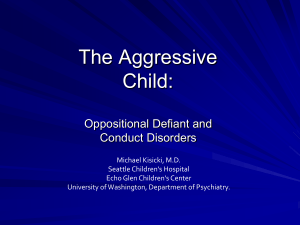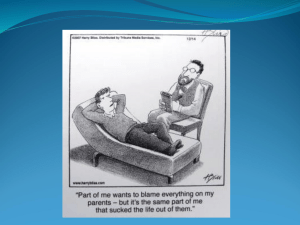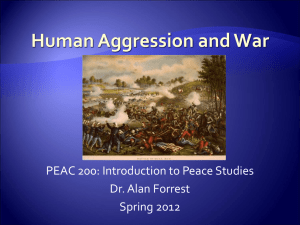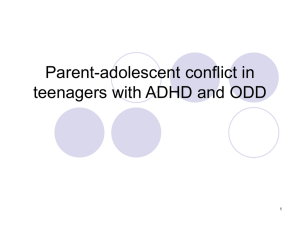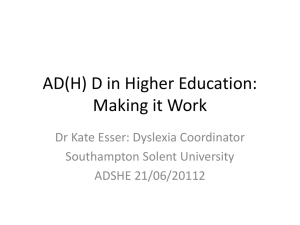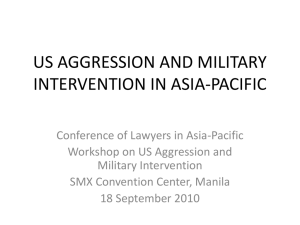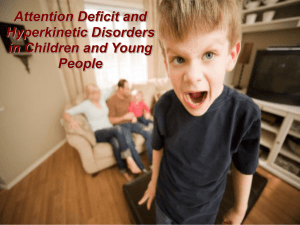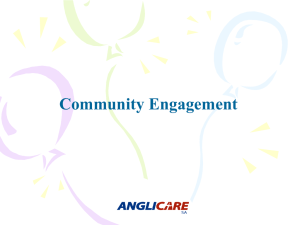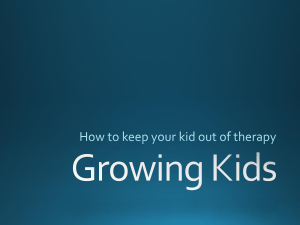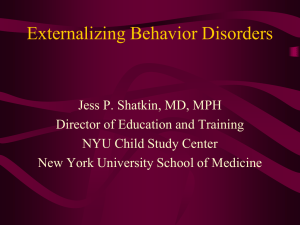Angry, Naughty Children
advertisement
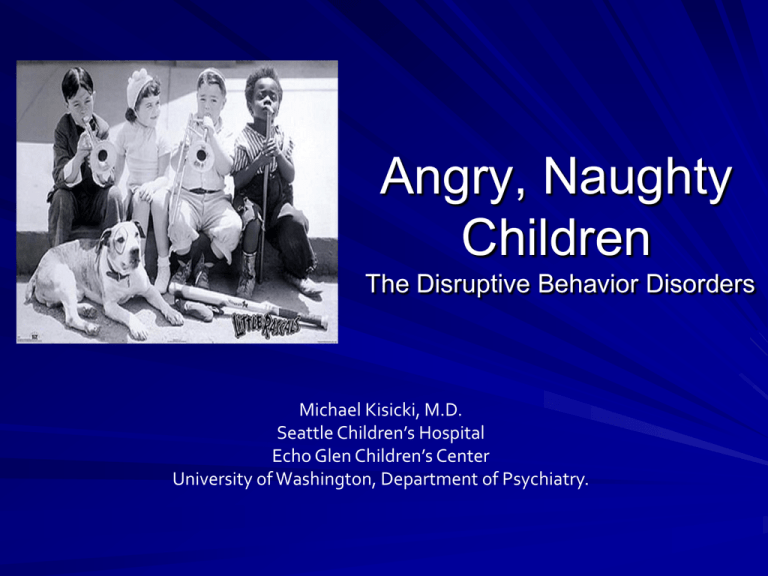
Angry, Naughty Children The Disruptive Behavior Disorders Michael Kisicki, M.D. Seattle Children’s Hospital Echo Glen Children’s Center University of Washington, Department of Psychiatry. Outline Definition and Clinical Picture Prevalence and Trends Etiology and Development Risk Factors Treatment (community, individual, medication) Common Clinical Situations (ADHD, aggression) Oppositional Defiant Disorder Defiance, anger, quick temper, bullying, spitefulness, usually before 8 years of age Usually resolves, 1/3 develop conduct disorder High rate of comorbidity ODD vs. Normal Kid Chief complaint: Angry, naughty child TOM ANDY ODD vs. Normal Kid Is it impairing? Are symptoms present at home AND school? Is there a new temporary stressor? Did they function well in the past? Conduct Disorder Repetitive + persistent, violates basic rights of others or societal norms Aggression, property destruction, theft, deceit, truancy Prognosis depends on age, aggression and social withdrawal Boys: higher prevalence, more persistence and aggression Girls: less persistent, more covert behavior and problematic relationships Less Aggression and more rights violations with age. Not Just a Phase Younger age of onset Variety and number of symptoms Proactive aggression and cruelty Behavior atypical for age and gender Weapon Not in social context Prevalence 5% of kids ODD: 2-16% of community, 50% of clinic CD: 1.5-3.4% of community adolescents, 30-50% in clinic Adult antisocial personality disorder: 2.6% Slight increase by generation Boys >> girls Prognosis and Outcomes Cost to individual, family and society Psychiatric comorbidity Substance abuse Educational problems Unemployment Delinquency/Criminality Violent relationships Teen pregnancy Generational transfer Comorbidity* ADHD 10x more common Major Depression 7x more common Substance Abuse 4x more common Anxiety ?????? ETIOLOGY / RISK FACTORS DEVELOPMENT Normal Prosocial infant behavior Toddler independence “Terrible two’s (and threes)” Adolescent experimentation WORRY Milestone deviation Aggression after 8 years Drug experimentation prior to adolescence Biology Genetics (50%) Anatomy (frontal, temporal lobes) Chemistry (seretonin, cortisol, testosterone) Autonomic arousal Toxins Psychology Temperament Intelligence, reading, speech/language Social skills Cognition Parenting Parental mental illness* Low involvement High conflict Poor monitoring Harsh inconsistent discipline* Physical punishment Lack of warmth and involvement Parental burn out* Child Abuse Physical abuse and neglect predict APD, criminal behavior, violence Abused children have social processing deficits Sexual abuse victims of both genders develop DBD, girls have more internalizing Peers Rejected and reinforced by prosocial peers* Uneasy affirmation by anti-social peers* Females more sensitive to rejection Neighborhood More predictive of DBD than any other psychopathology Public housing outweighs all protective factors* Disorganization, drugs, adult criminals, racial prejudice, poverty, unemployment Evaluation Co-morbid conditions (ADHD, substance abuse, mood, anxiety/PTSD, lead toxicity, brain trauma) Look for recent changes or new stressors Evaluate for modifiable risk factors Information from multiple sources (parent, teacher, probation) Vanderbilts, Overt Aggression Scale Treatment Menu Education Treat co-morbid medical and psychiatric conditions Parenting support Psychotherapy Community/Multimodal services Medication What’s ineffective? Boot camps Job programs Peer counseling Home detention Scared straight Education Drugs, toxins Parenting/abuse Parent mental health Learning problems Peers, community Safety precautions Available resources Communication Comorbidity ADHD: medication and parenting support +/- behavioral therapy Substance abuse: targeted treatment, motivational interviewing, consider residential Mood/Anxiety: individual therapy (CBT) +/- medication Psychotherapy Part of a broader program Problem solving Social skills Moral development ? anger/assertiveness training ? rational emotive therapy Parenting Support Parent management training (PMT): effective across settings and overtime, but does not bring out of clinical range Parent-Child Interaction Therapy (PCIT): clinically significant improvement with ODD. 1. Child directed interaction. 2. Parent directed Family Therapy has greater drop out than PMT Parenting in Primary Care RCT of bibliotherapy versus 12 session parenting program www.incredibleyea rs.com (Free and Purchased material) Bibliotherapy 1-2-3 Magic (2004) by Thomas Phelan, PhD (multiple languages and video) Winning the Whining Wars, and other Skirmishes (1991) by Cynthia Whitham MSW The Difficult Child (2000) by Stanley Turicki, MD Parenting Your Out-of-Control Teenager by Scott Sells, PhD Parenting Positive reinforcement Balanced emotional valence Time outs Parenting (con’t) Response cost: withdrawing rewards Token economy Consistency of response Priorities and sharing responsibility Community Get Creative! Scouts, Boys and Girls Clubs, Big Brother/Sister, after school activities and sports, communal parenting Be careful of bringing together kids with ODD/CD More formal programs: treatment foster care, school-based programs, bullying programs Multimodal Services Strongest evidence for actual therapeutic effect Foster care, juvenile justice, public mental health Multisystemic therapy: family, peer, school, and neighborhood interventions DSHS explanation of Wraparound Services. http://www.dshs.wa.gov/mentalhealth/guidetotailor edcare.shtml. Pharmacotherapy Rule out and treat ADHD, depression, Bipolar, psychosis first After psychosocial interventions fail Poor response without co-morbid condition Not just stimulants are diverted! Marvin 11 yo healthy boy, normal development Irritable, rambunctious Talks back to teachers and parent Flopping in school. Kids don’t like him. Hard to get to sleep Family history of bipolar disorder ADHD and ODD/CD ODD is most common comorbidity in ADHD, occurring in 60% Earlier age of onset and impairment More likely progression to CD and other psychiatric illness More aggression and substance abuse (double the risk, compared to ADHD alone) Similar but different from Bipolar ADHD + ODD/CD Treatment ADHD = ADHD+ODD in stimulant response Non-Stimulant medications not as consistent 11x the non-compliance with ODD Meds + parenting and/or behavioral therapy Combination therapy is better when comparing “normalization,” and dosage of medication and parent preference Alex 12 yo healthy foster boy, unknown development Bullies younger kids, tortures animals Foster parent scared Truant, history of poor academics Aggression Overt, reactive aggression is most responsive Covert, premeditated aggression is less responsive Clear quantifiable goals, use of scales (OAS) Keep it simple, one thing at a time. Stop interventions that don’t help. Modest expectations. Aggression Treatment Treat comorbid conditions Early intervention is key, solidified by age 10-12 years 2-6yo: parent management training (PCIT, PMT) 6-12yo: peer mediation, anger management, conflict resolution training, and assertiveness Teens: multimodal therapies, CBT Education: speech and language pathology (expressive/receptive), reading and writing learning disorders Aggression Psychoharmacology Atypical Antipsychotics: (Risperidone). Hostility, impulsivity, hyperactivity and aggression CD, BAD, psychosis, autism spectrum disorders, intellectual disability Mood Stabilizers: Lithium has large effect size (>1) in multiple trials. Depakote has some efficacy, may be greater at higher serum levels. Carbamazepine has not shown good benefit Aggression Psychopharmacology (Con’t) Alpha Agonists: Clonidine modestly effective in reducing aggression, even without ADHD. Guanfacine not really studied. Stimulants: Very effective when there is comorbid ADHD but questionable without ADHD Thank you for coming! Please feel free to email me with any questions Michael.kisicki@seattlechildrens.org For specific clinical questions, contact PAL at 1866-599-PALS Acknowledgement Dr. Terry Lee Dr. Robert Hilt
